Ajrakh Print Dresses: A Timeless Elegance That's Making a Comeback
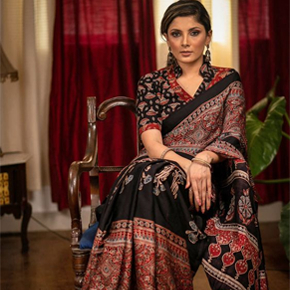
Ajrakh print dresses, with their mesmerizing patterns and rich heritage, have woven their way into the contemporary fashion scene, capturing the hearts of fashion enthusiasts worldwide. Rooted in the culturally diverse land of India, Ajrakh print is a traditional form of block printing that dates back over 4000 years. The word Ajrakh is derived from the Arabic word Azrak, meaning blue, which is a prominent color in these intricate designs. Over the years, Ajrakh print has gained immense popularity for its artistry and cultural significance, evolving from being a traditional craft to a global fashion statement.
Ajrakh prints have not only preserved their rich heritage but have also evolved into a source of inspiration for fashion designers around the world. Renowned designers like Anita Dongre, Ritu Kumar, and Manish Malhotra have seamlessly incorporated Ajrakh prints into their collections. These prints offer a unique blend of tradition and contemporary aesthetics, making them a preferred choice for both ethnic and fusion wear. The harmonious blend of earthy colors, geometric patterns, and natural motifs has allowed designers to create captivating ensembles that appeal to a diverse range of fashion enthusiasts.
History of Ajrakh Prints
The history of Ajrakh prints is a tapestry woven with stories of artisans and traditions passed down through generations. This ancient art form has its origins in the regions of Sindh, India, and is deeply rooted in the local culture. Historically, Ajrakh fabric was used as garments by the Maldhari community, a nomadic tribe in Gujarat, for its incredible comfort and ability to withstand the harsh desert climate. The process of creating Ajrakh prints involves a meticulous combination of natural dyes, intricate block printing, and repeated washing, which can take several weeks to complete. This commitment to craftsmanship and artistry has sustained the tradition for millennia. Ajrakh art form is widely practiced in the Indian state of Gujarat, specifically in the Kutch region, as well as in certain parts of Rajasthan. Additionally, Ajrakh printing is also practiced in some areas of Sindh province in Pakistan, particularly in communities that have a historical connection to this art form.- Kutch, Gujarat, India::
The Kutch region of Gujarat is renowned for its Ajrakh printing tradition. In this region, various communities, including the Khatri and Meghwal communities, have been practicing Ajrakh printing for generations. The Kutchi Ajrakh is known for its distinctive patterns and vibrant colors. - Barmer, Rajasthan, India::
While not as widespread as in Kutch, Ajrakh printing is also practiced in the Barmer district of Rajasthan. The designs and techniques used in Barmer may have slight variations compared to those in Gujarat, reflecting regional influences. - Sindh, Pakistan::
Ajrakh printing has historical roots in Sindh, Pakistan, particularly in regions like Umerkot and Tharparkar. The art form is practiced by Sindhi artisans who have preserved this tradition over generations.
Ajrakh Printing: The Process
The process of creating Ajrakh prints involves the following steps:- Preparing the Fabric::
Usually, natural fabrics like cotton and silk are used. The fabric is washed and soaked to prepare it for dyeing. - Printing with Wooden Blocks::
Artisans use intricately carved wooden blocks to apply the design onto the fabric. These blocks are dipped in natural dyes and then stamped onto the fabric. This process is repeated multiple times to create complex patterns. - Dyeing with Natural Colors::
The fabric is dyed using natural colors obtained from sources like indigo, madder root, and various other plant-based materials. Each color is applied in stages, with some areas being blocked off to preserve previous colors. - Washing and Drying::
After each dye application, the fabric is washed to remove excess dye and then dried in the sun. This process may be repeated several times to achieve the desired colors and patterns. - Final Touches::
Once the fabric has gone through multiple printing and dyeing cycles, it is finished with intricate border designs and sometimes even additional hand-painted details.
Trending Ajrakh Print Dresses
In recent times, the allure of Ajrakh prints has surged, becoming a prominent trend in the fashion industry. From runways to street style, Ajrakh print dresses are making a comeback with a modern twist. Here are a few trending Ajrakh print dresses that have taken the fashion world by storm:- Ajrakh Maxi Dresses:
Long, flowing maxi dresses featuring Ajrakh prints are a hit among fashionistas. These dresses offer comfort, style, and a touch of boho chic, making them perfect for casual outings or beach vacations. - Ajrakh Sarees:
Ajrakh print sarees are a timeless classic. They exude elegance and are perfect for both traditional occasions and contemporary celebrations. Celebrities and fashion influencers have embraced these sarees, making them a must-have in every woman's wardrobe. - Ajrakh Kurtis:
Ajrakh print kurtis are versatile and easy to style. They can be paired with jeans, leggings, or palazzos for a chic and comfortable everyday look. The bold prints and vibrant colors add a unique flair to casual wear. - Ajrakh Lehengas:
Brides are also embracing the charm of Ajrakh prints for their wedding attire. Ajrakh print lehengas with intricate hand-embroidery are creating a buzz in the bridal fashion scene, offering brides a unique and culturally rich option.
Trending Ajrakh Print Dress Collections of 2023
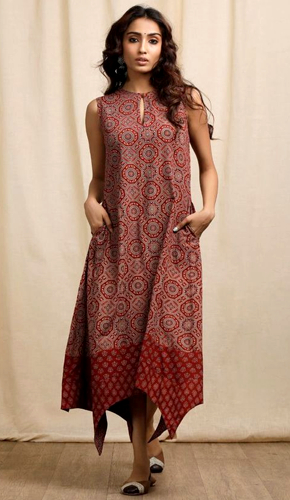

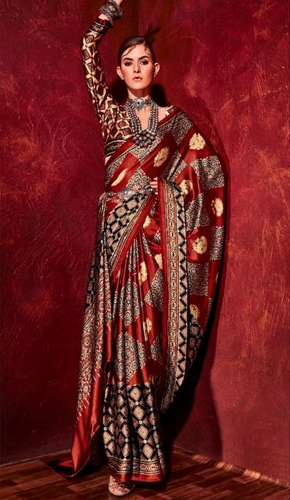


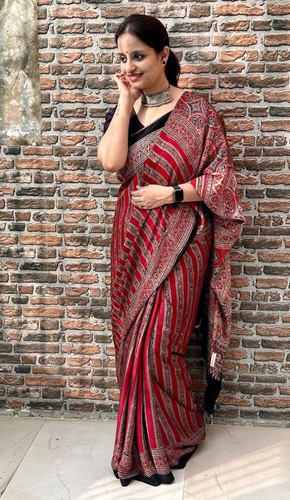







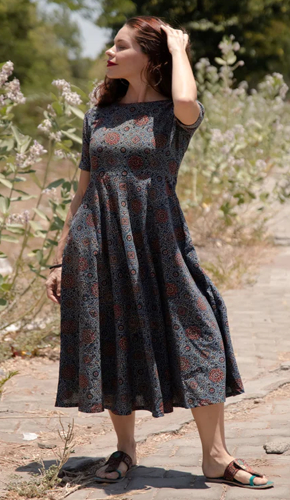

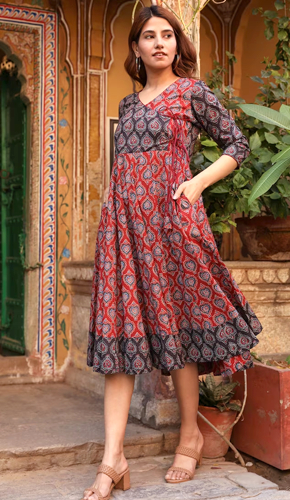
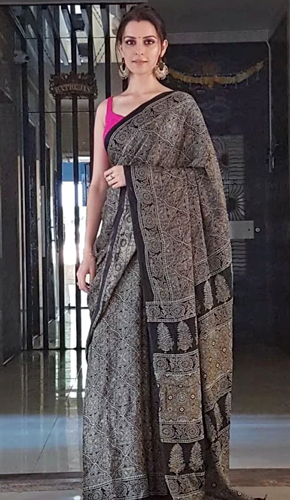

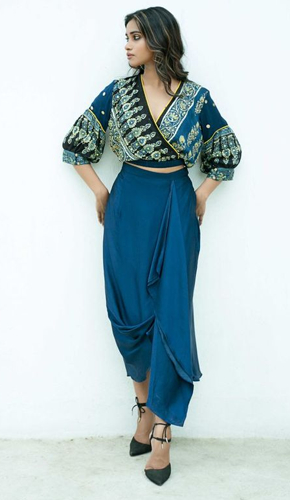

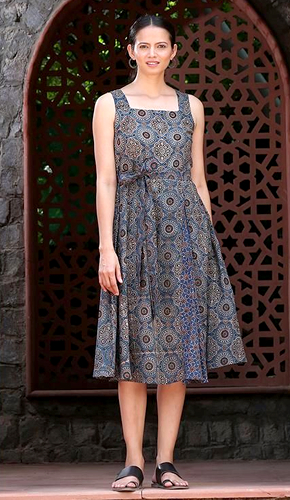
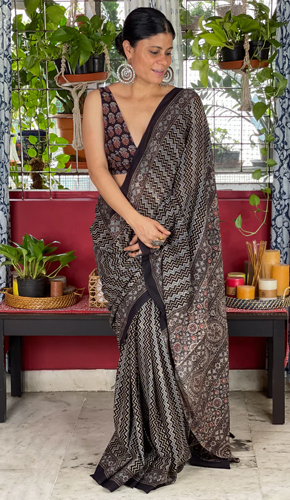
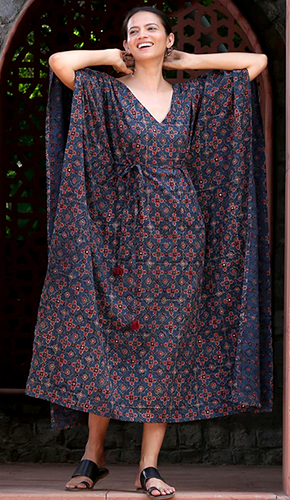



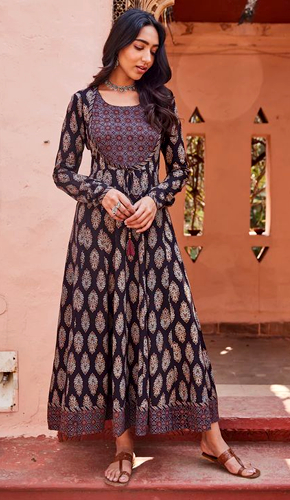






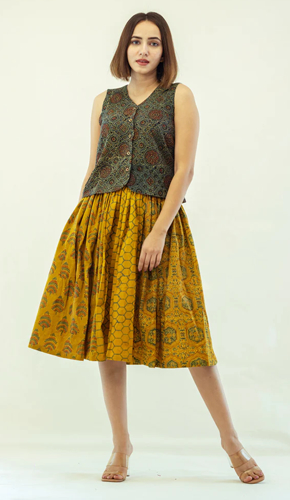


Important Role of Fashion Institutes in promotion Ajrakh Prints
Fashion Institutes across the globe have recognized the importance of preserving and promoting traditional textile arts like Ajrakh printing. These institutions emphasize the need to understand and appreciate the heritage behind Ajrakh prints as a part of their curriculum. Students are encouraged to explore the intricate processes involved in creating Ajrakh prints, from dye preparation to block printing, and are taught how to infuse these techniques into modern fashion designs. This commitment to nurturing traditional craftsmanship ensures that the art form continues to thrive and inspire new generations of designers.Fascinating Ajrakh Print Facts: From Ancient Origins to Global Recognition
Ajrakh is a traditional block-printing technique and textile art form that has been practiced for centuries in the Indian subcontinent, particularly in the regions of Gujarat and Rajasthan. Here are some interesting facts about Ajrakh and Ajrakh prints:- Ancient Tradition:
Ajrakh printing has a history that dates back over 4,000 years. It is believed to have originated in the Indus Valley Civilization, making it one of the oldest known textile printing techniques. - Natural Dyes:
Traditional Ajrakh prints are known for their use of natural dyes made from plants and minerals. Colors are derived from sources such as indigo, madder root, turmeric, and pomegranate rinds. - Complex Process:
Creating an Ajrakh print is a labor-intensive process that involves multiple stages of dyeing and printing. The fabric is washed and soaked in various natural dyes multiple times to achieve the desired colors and patterns. - Block Printing:
The printing of Ajrakh patterns is done using hand-carved wooden blocks. These blocks are meticulously designed and carved with intricate geometric and floral motifs. - Reversible Designs:
One unique feature of Ajrakh prints is that they are often reversible. The same intricate design can be seen on both sides of the fabric, showcasing the skill and precision of the artisans. - Symbolism:
Many Ajrakh patterns carry cultural and symbolic significance. They often incorporate elements like stars, crescent moons, and other traditional motifs that have historical and spiritual meaning. - Sustainable and Eco-friendly:
Ajrakh printing is known for its eco-friendly and sustainable practices. The use of natural dyes and traditional techniques minimizes the environmental impact of the textile industry. - Cultural Significance:
Ajrakh-printed textiles are deeply rooted in the culture and identity of the communities that produce them. They are worn on various occasions, including weddings and festivals, and are considered a symbol of pride and tradition. - Geographical Indication (GI):
In 2016, the Ajrakhpur region in Gujarat, India, was granted Geographical Indication status for its Ajrakh prints. This recognition helps protect the authenticity and heritage of Ajrakh. - Contemporary Adaptations:
While traditional Ajrakh prints remain popular, contemporary designers have also incorporated Ajrakh techniques into modern fashion, creating a fusion of tradition and innovation. - Global Recognition:
Ajrakh prints have gained international acclaim and are sought after by fashion designers and enthusiasts worldwide. They have been featured in fashion shows and exhibitions in various countries. - Artisan Communities:
Ajrakh printing is often a family tradition passed down through generations. The artisans who practice this craft play a crucial role in preserving this ancient art form.
| Published On | - | 2023-09-17 |
| Modified On | - | 2023-09-19 |
| Author | - | Team WIFD |
| Publisher | - | Waves Fashion Institute |
| https://wifd.in//influence_of_ajrakh_prints_in_fashion | ||




Discover the timeless wisdom & style insights from 15 iconic fashion designers. Explore their memorable quotes & be inspired to embrace fashion with flair.

Meet the fashion brands that are leading the green revolution. Sustainable, stylish, and making a positive impact!

Ahaana Krishna in 'RENA', the most recent Bridal Collection captivating blend of contemporary elegance and Japanese charm.

Step into the world of refreshing elegance as Raashi Khanna dazzles in a lime green, sheer saree during the 'Aranmanai' trailer launch at Chennai